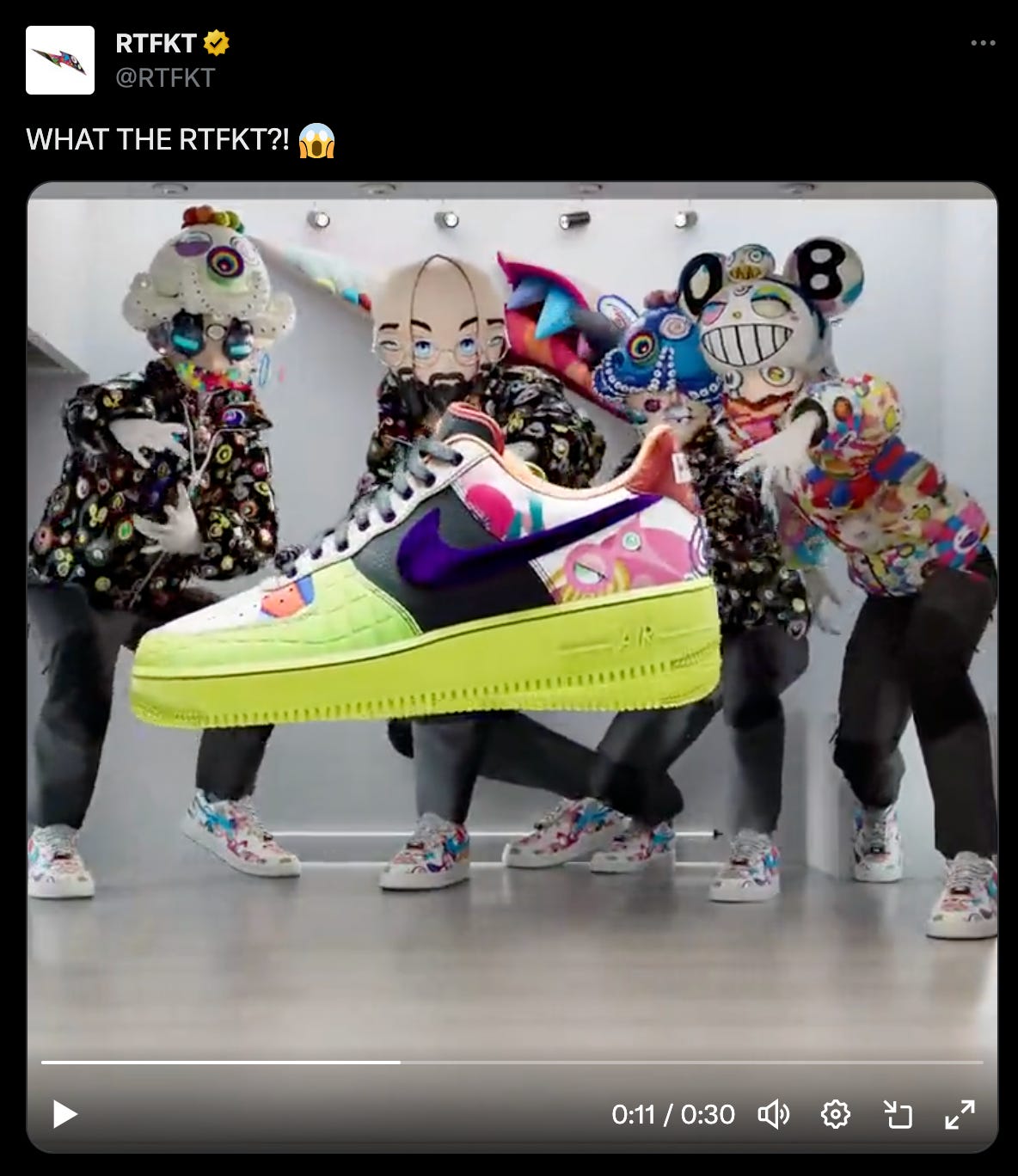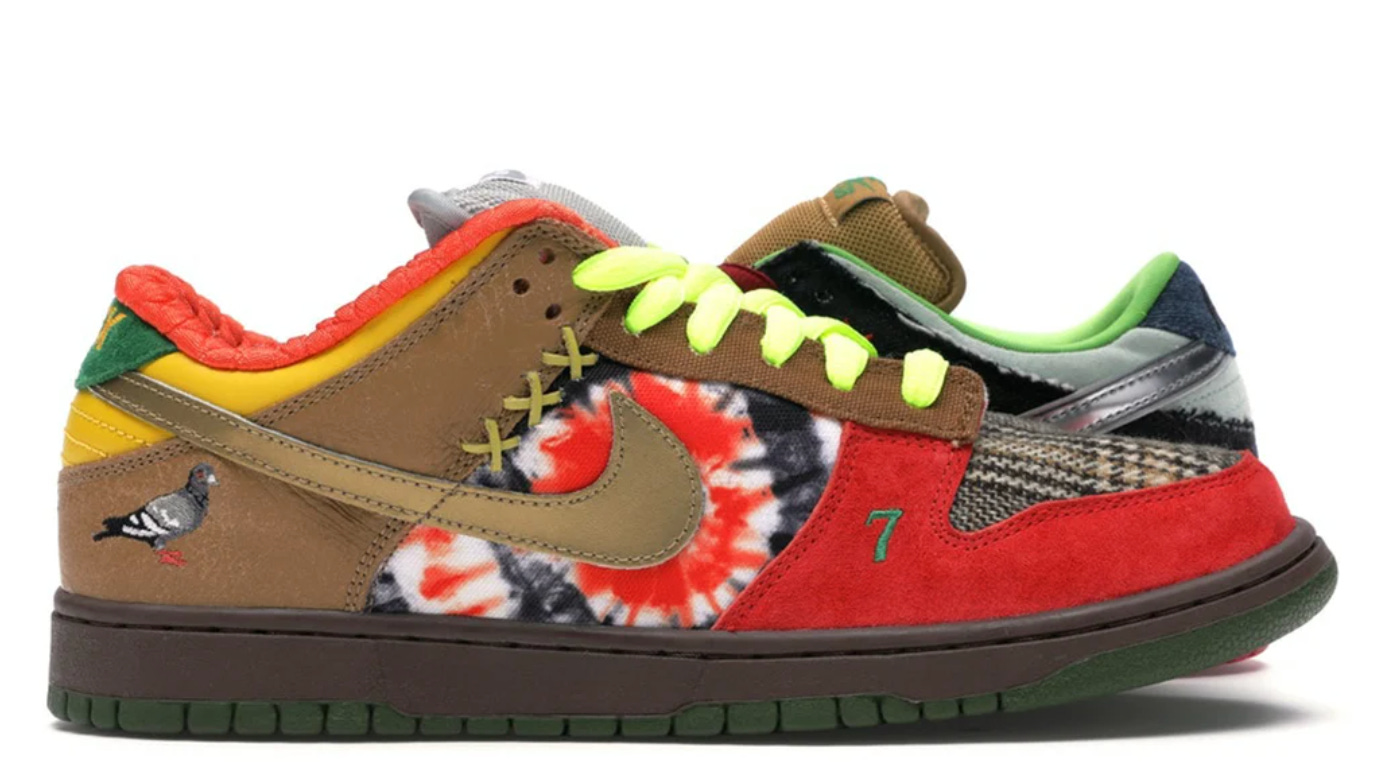#245: Rewarding Signal vs. Noise with RTFKT
PLUS: 👟 What does forging for the RTFKT Genesis Dunks look like?
I did it, I got married folks! I’m living proof that it’s possible to work in this industry and have a significant other. Shoutout to A, my wife(!!) for supporting me and listening to me blabber nonstop about this space.
Rewarding signal with RTFKT
Amidst all the excitement about crypto being back thanks to Blackrock’s Bitcoin ETF ticker being listed (which was removed, then relisted, then discovered to have been listed since August lol), RTFKT surprised their community with a new colorway of the RTFKT x Nike Air Force 1s: WHAT THE RTFKT?!
If you’re wondering “WHAT THE RT F KT is that?!” I understand. The ‘What The’ style is not for the faint-hearted.
What the hell is ‘What The’?
The ‘What The’ colorway’s history began in 2007 when the ‘What The Dunk’ was released.
This style mixes and matches popular colorways from previous releases to create a Frankenstein-ed version of the sneaker. What The has been released over the years across various sneaker silhouettes, bought by diehard fans and collectors.
RTFKT has now hopped on that train as well. But…who was eligible to get these Air Force 1s?
The WHAT THE RTFKT?! was earned. In order to qualify, users had to forge all 10 of the original colorways, and there were only 40 people/wallets who qualified. These pairs were subsequently gifted to them and start shipping out this week.
Why is this notable?
It’s been a while since I’ve come across a nice example of ‘surprise and delight’ in web3, and this certainly was a significant one for RTFKT and sneaker fans. The fact that there are only 40 pairs that were manufactured puts this sneaker up as one of the rarest pairs of Nike sneakers in recent history.
This touches upon a theme I’ve been thinking about for a while and will continue to be a theme that I think everyone (projects, companies, brands big and small, web2, web3, etc.) is exploring: How do you effectively reward engagement?
The answer to that today is simple and has proliferated everywhere: based on transactional or social activity:
Transactional: Rewards points based on spend volume, eg: airline loyalty programs
Social: Sweepstakes entries based on following certain accounts or sharing content

However, one of the reasons web3 is interesting is because the technology allows for a better understanding of depth and breadth of engagement.
How might this work?
In a hypothetical situation, let’s say the sneaker industry was tokenized. Crazy I know — Every pair of sneaker is tokenized, so you can see who owns what sneakers and how many pairs.
You can understand who is purchasing sneakers directly from the brand, who is purchasing through 3rd parties (like Footlocker or Amazon), who’s purchasing second-hand, or who is purchasing from resell sites like StockX and eBay.
Besides the fact that this is a little creepy (but already happens behind the scenes), there are clear benefits. Companies and brands truly know who their real fans are.
What do I mean by that, ‘truly know who their real fans are’?
Transactional volume in the sneaker world is a directionally helpful indicator, but one that could lead to some false positives.
Someone can spend $100k in sneakers to collect and rock them or spend $100k in sneakers to sell them for $200k. There isn’t necessarily anything wrong with the latter scenario, it’s a free market after all. But if I had an invite-only event for the top sneaker collectors in the world, I would want the guy on the left to attend.
Taking this a step further, what if there was a sneaker megafan that purchased a ton of sneakers on a secondary marketplace like StockX to collect and wear? Wouldn’t the sneaker brand want to know who those people are and reward them for their fandom?
You can easily make the argument that someone who is willing to purchase a pair of sneakers at a 50% resale markup is a bigger fan than a bot that purchased the same pair at retail price directly from the brand’s website.
This is why Nike’s RTFKT’s forging concept helps the brand understand depth and breadth of engagement. How?
The RTFKT x Air Force 1s went through a multi-step process to go from NFT to physical product:
Note the two layers of engagement rewards:
T-shirt (quantity-based reward): Each forged pair of Air Force 1s comes with a complimentary t-shirt. Forge 1 pair, receive 1 t-shirt. Forge 100 pairs, receive 100 t-shirts.
WHAT THE RTFKT?! (combination-based reward): Forge every colorway and receive an exclusive pair of Air Force 1s.
Why are these engagement rewards? Remember that payment was at the Pre-Forge stage. Forging was free (only have to pay gas), but you had to take the action of forging in order to receive them.
And although most people forged their Air Force 1s since they were already paid for, not everyone did.
You needed a Clone X to mint the Pre-Forge version of the sneakers, but you could have purchased them on the secondary market and then forged them if you wanted to complete the set of Air Force 1s.
Transparency in secondary market activity facilitates more effective intention-based engagement rewards.
Going one step further
How could this engagement-based rewards model go even further?
Last month, I wrote a piece about RTFKT’s new mobile app, CryptokickIRL. What’s the ultimate form of engagement for sneakers?
Wearing them! RTFKT sneakers are embedded with a WM (World Merging) chip that not only verifies ownership but will also be able to track steps.
With this last step in the sneaker funnel, RTFKT is able to track and understand engagement from purchase to usage. As a result, the team has the opportunity to reward the right people in the most relevant ways:
Have you forged every colorway of RTFKT x Air Force 1s? Receive a complimentary and exclusive Air Force 1.
Have you walked 1 million steps in one pair of RTFKT sneakers? You probably really like that pair of sneakers. Receive that same pair as a gift.
Have you connected and walked in 10+ unique pairs of RTFKT sneakers? Receive a 50% discount on the next release because you actually wear your sneakers.
Do you always forge the max allocation you are allowed? You now get to mint +1 allocation for the next release.
The mechanisms and rewards expand because you understand product engagement on the user level and product level. The fact that a brand like RTFKT operates in both the digital and physical space allows for engagement to be measured in a richer way, and rewards can get more creative.
I hope we begin to see more unique reward structures that move beyond transactional volume. Blockchain and NFTs allow this to be executed more confidently.
RTFKT x Nike Dunk Genesis forging begins
With the RTFKT x Nike Air Force 1s complete, we now go to the next pair of RTFKT sneakers being forged: RTFKT x Nike Dunk Genesis.
With a week left to forge (ends October 30th), the number minted supply seems low. I imagine the procrastinators will come out in full force as the deadline approaches.
Why is the Void colorway supply “40,000+”? There will be a public sale involved with that colorway, opening up the opportunity to purchase without needing an NFT or acquiring them on a secondary marketplace.
We’ll see how these do in the coming weeks.
See you Thursday!













Is it just me or does your wife look a little blue?
Looking slick at the altar there pal!